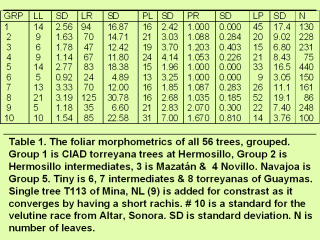 |
The same basic tree is seen in Groups 1, 5 & 8,
no longer supported by the watertables of Hermosillo & Guaymas. Group 6 at
Guaymas is race Tiny with light green leaves, the logical response to water
stress. Having reached a given heterozygocity, Tiny is now backcrossing
torreyana Group 8 to form Group 7 intermediates. T113 as # 9 has dark green
leaves like velutines, but its migratory origin is in the southeastern
mountains of San Luis Potosí. It demonstrates the tendency to shorten the
rachis in drought. It has no 1 PR leaves. See Earl (1998) on convergence.
Tree T113 # 9 packs its leaflets along the rachis at 1.67 mm spaces, whereas
the velutine # 10 packs them at 2.74 mm. Hilu et al. (1982) have 6.11 mm for
their torreyana and 3.81 mm spaces for their velutine by calculation, and
6.1 & 3.6 mm by measuring. Then that measurement is redundant. EasternT113
converges with the western velutine race. Hilu’s velutine has been diluted.
From north to south, the 2 PR velutine gradient coming from the north runs :
67 % Hermosillo, 23 % Mazatán, 10 % Guaymas & 0 % Navajoa. |
